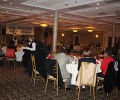| Koreans Say Boston Has Become ‘Delicious’ |
| 보스톤코리아 2012-01-09, 15:13:04 |
Translated SeungYeon Woo A few years ago, Koreans and Korean restaurants had conflicts about misunderstanding the proper amount for a tip, poor service, and tasteless dishes. After the conflicts, what has changed about eating out in Boston? Most of Koreans’ responses were very positive. A graphic designer, Sun-hee Choi, said, “In the past, the menus did not have much variety. Most restaurants had similar menus such as Kimchijjigae and Dolsotbibimbap. However, these days, each restaurant has its own special menu.” Choi added, “I thought street vendor style Tteokbokki, Gamja bbyuhjjim and Hoi Moochim would be the kind of dishes that I would never be able to try in Boston. However, now I can enjoy them anywhere easily. I no longer have to long for Korean foods I want to eat by listing them on paper and waiting to go to Korea or New York.” People not only complimented the increased variety of entrees, but they also talked about the improvement of side dishes. Hyun-tae Kim, a student at BU School of Law, said, “There were only three kinds of side dishes, such as Sookju Namul, Shigeumchi Namul and Kimchi, in most of the restaurants. These days, Yasu, Koreana, Chungkiwa and some other restaurants serve about 5 to 7 side dishes. Also, the employees are now very generous about giving extra upon our request.” The price is also one of the important things about restaurant food. Jeong-im Lee, a 3rd year chemistry student at Wellesley College, said, “First of all, the price went down. I assume it’s because of the increased competition among Korean restaurants. Moreover, since people can get Korean ingredients easily from H Mart now, restaurants are trying to attract more customers by pricing their menus down. The owner of my favorite Korean restaurant said he removed the most expensive dishes from the menu. It’s good news for the customers.” How have Koreans’ attitudes about the tip changed? A business student at Brandeis University, Seok-woong Yoo, said, “Of course I have to pay the tip. Although I calculate the percentage with a calculator, I no longer grudge money for the tip like I did in the past. Korean students now come to the U.S. by preparing and learning about American culture through travel guide books and online. Thus, most of them understand the tip custom correctly.” Nevertheless, people are still wondering if service and sanitation have improved as the number of restaurants and menus have increased. A housewife, Jeong-eun Kim, who was once a waitress said, “I know that some restaurants have extended their hours to 2 A.M. Also, employees are not rude to the customers anymore, since customers can complain through online bulletin boards, which have become very active these days. However, I think that restaurants still have to improve on their sanitation and service by hiring more skilled and experienced employees.” ⓒ 보스톤코리아(http://www.bostonkorea.com), 무단전재 및 재배포 금지 |
 |
 의견목록 [의견수 : 0]
의견목록 [의견수 : 0]
|
 |
| 등록된 의견이 없습니다. | |
|
|
 프리미엄 광고
프리미엄 광고

161 Harvard Avenue, Suite 4D, Allston, MA 02134
Tel. 617-254-4654 | Fax. 617-254-4210 | Email. [email protected]
Copyright(C) 2006-2018 by BostonKorea.com All Rights Reserved.
Designed and Managed by Loopivot.com




























